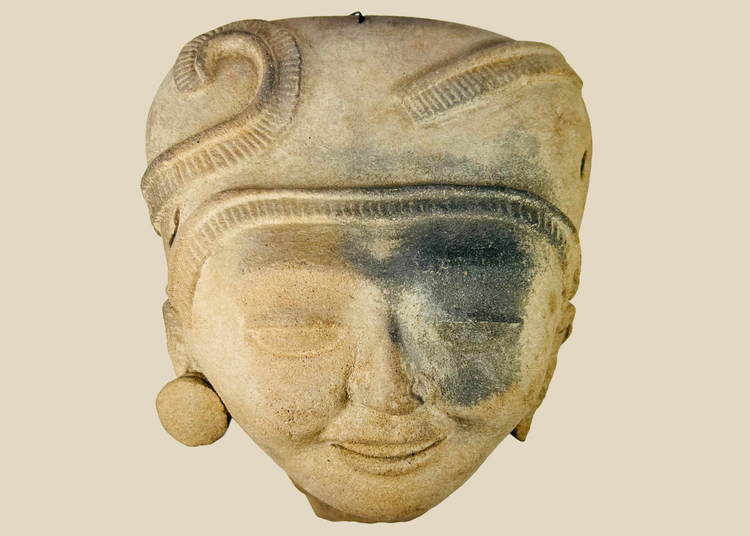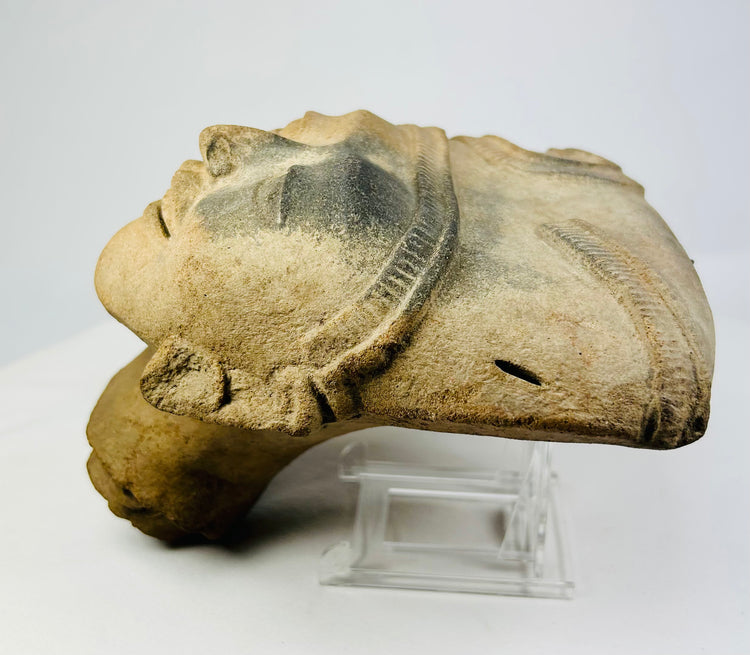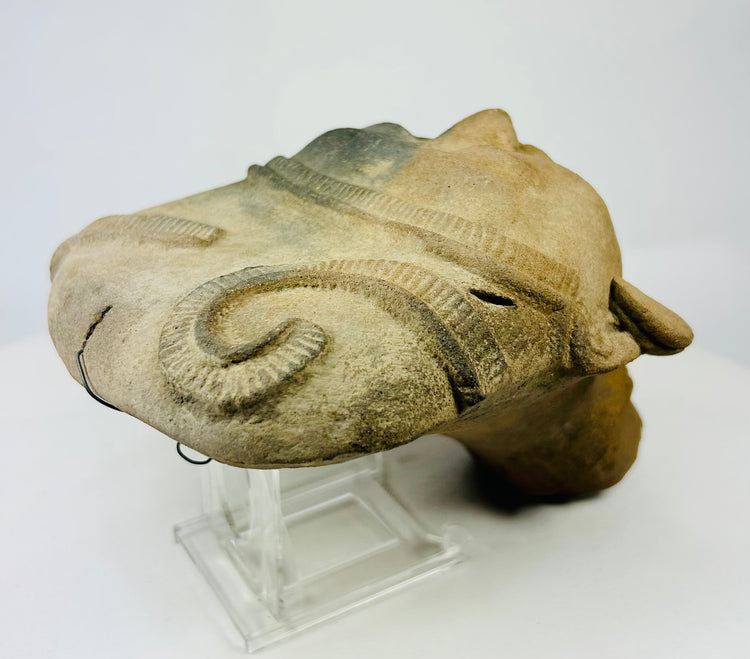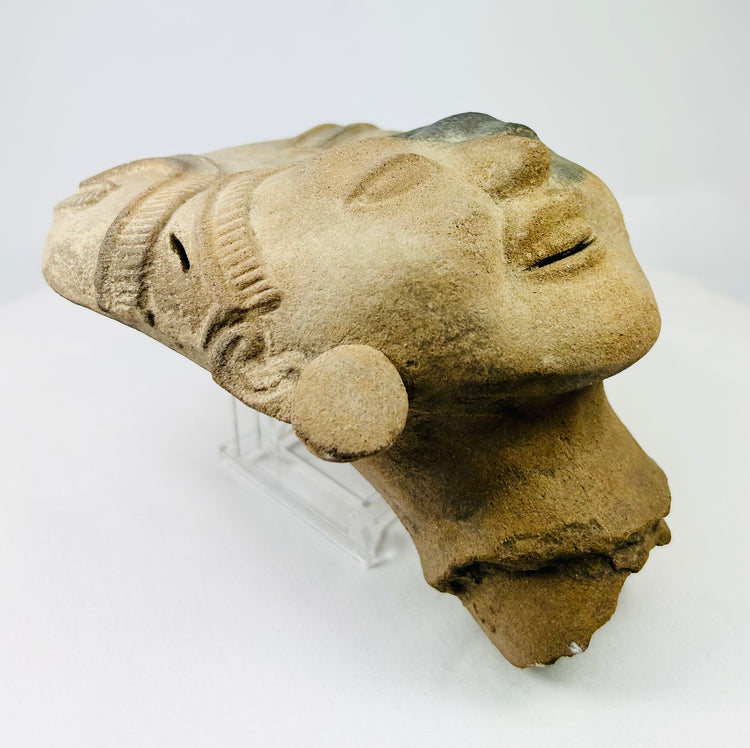Pre-Columbian Terracotta Head Fragment | West Mexico | Circa 300 BCE–500 CE
Description
More
Less
Historical Context & Origin
Region: Western Mexico (likely Nayarit or Jalisco culture)
Material: Fired terracotta with mineral surface deposits
Period: Circa 300 BCE–500 CE
Description
A finely modeled terracotta head fragment from ancient West Mexico, depicting a serene male or female figure with prominent circular ear ornaments and elegantly stylized hair rendered in sweeping, incised bands. The face bears the characteristic calm expression of Nayarit and Jalisco effigies, with closed almond eyes and softly smiling lips conveying an otherworldly tranquility. Subtle surface darkening and mineral encrustation attest to its great age and long burial. The reverse shows the original hollow construction typical of West Mexican shaft tomb sculpture. This piece would once have formed part of a full-bodied ancestral figure, created to honor lineage and accompany the deceased into the afterlife.
Features
- Distinctive West Mexican modeling with stylized coiffure and earspools
- Original firing and mineral accretions intact
- Graceful expression embodying the spiritual dignity of Pre-Columbian artistry
- Fragment from a larger hollow-cast effigy
- Stable condition suitable for professional display
Cultural Significance
Figures such as this were central to the funerary traditions of ancient West Mexico. Buried within shaft tombs alongside offerings and ceremonial vessels, these effigies represented ancestors or divine intermediaries believed to guide and protect the soul on its journey. The artistry of such sculptures reflects both the technical sophistication and deep spiritual beliefs of early Mesoamerican societies—celebrating continuity, reverence, and eternal presence.
Condition
Excellent fragmentary preservation with natural surface patination, encrustation, and areas of ancient smoke or firing marks. Minor loss at the lower neck edge, consistent with excavation and age. No restoration.
Dimensions (approximate)
Height: 6.5 in
Width: 5.5 in
Depth: 4 in (16 × 10.8 × 9 cm)
Age
Circa 300 BCE–500 CE
Learn More
West Mexico Shaft Tomb Figures — The Metropolitan Museum of Art
An authoritative museum page that describes hollow ceramic figures created for ancient West Mexican shaft tombs, detailing manufacturing techniques, social contexts, and burial practices.
Description
Historical Context & Origin
Region: Western Mexico (likely Nayarit or Jalisco culture)
Material: Fired terracotta with mineral surface deposits
Period: Circa 300 BCE–500 CE
Description
A finely modeled terracotta head fragment from ancient West Mexico, depicting a serene male or female figure with prominent circular ear ornaments and elegantly stylized hair rendered in sweeping, incised bands. The face bears the characteristic calm expression of Nayarit and Jalisco effigies, with closed almond eyes and softly smiling lips conveying an otherworldly tranquility. Subtle surface darkening and mineral encrustation attest to its great age and long burial. The reverse shows the original hollow construction typical of West Mexican shaft tomb sculpture. This piece would once have formed part of a full-bodied ancestral figure, created to honor lineage and accompany the deceased into the afterlife.
Features
- Distinctive West Mexican modeling with stylized coiffure and earspools
- Original firing and mineral accretions intact
- Graceful expression embodying the spiritual dignity of Pre-Columbian artistry
- Fragment from a larger hollow-cast effigy
- Stable condition suitable for professional display
Cultural Significance
Figures such as this were central to the funerary traditions of ancient West Mexico. Buried within shaft tombs alongside offerings and ceremonial vessels, these effigies represented ancestors or divine intermediaries believed to guide and protect the soul on its journey. The artistry of such sculptures reflects both the technical sophistication and deep spiritual beliefs of early Mesoamerican societies—celebrating continuity, reverence, and eternal presence.
Condition
Excellent fragmentary preservation with natural surface patination, encrustation, and areas of ancient smoke or firing marks. Minor loss at the lower neck edge, consistent with excavation and age. No restoration.
Dimensions (approximate)
Height: 6.5 in
Width: 5.5 in
Depth: 4 in (16 × 10.8 × 9 cm)
Age
Circa 300 BCE–500 CE
Learn More
West Mexico Shaft Tomb Figures — The Metropolitan Museum of Art
An authoritative museum page that describes hollow ceramic figures created for ancient West Mexican shaft tombs, detailing manufacturing techniques, social contexts, and burial practices.
You May Also Like



































